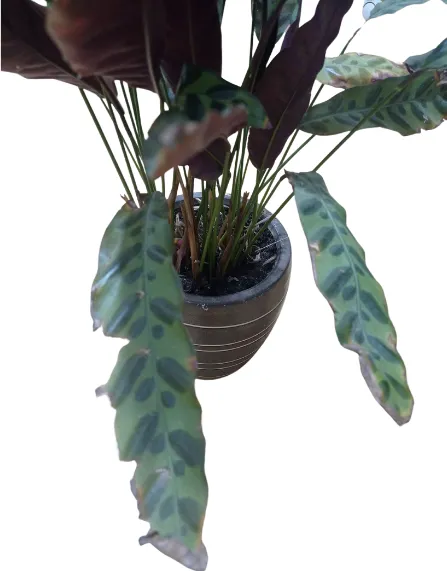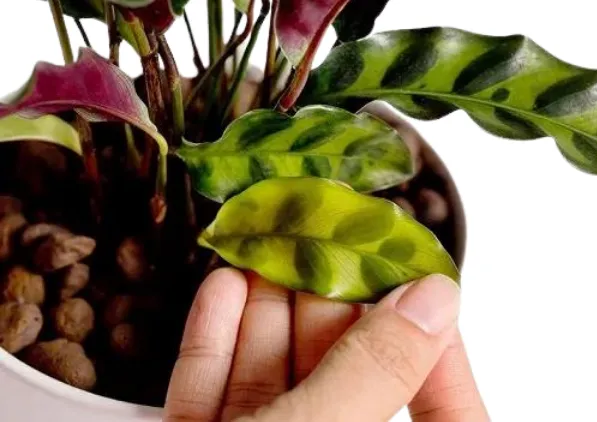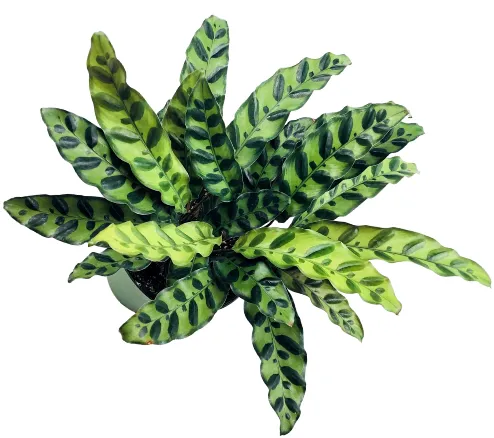Goeppertia Insignis, commonly known as Calathea Lancifolia or Rattlesnake plant, is a unique houseplant that originates from Brazil. It has distinctive deep green colored leaves shaped like spears. The plant gets the nickname of Rattlesnake plant due to the characteristic markings on the leaves that resemble rattle snakeskin patterns. The foliage of this plant also features beautiful purple undersides, which makes it stand out in any room.
Rattlesnake plants require more attention as compared to common houseplants, and if taken care of properly can grow up 30 inches. Its unique leaves and beautiful colors make it a stand-out plant. If you’re looking for an interesting and eye-catching houseplant, the Calathea Lancifolia is definitely worth considering.
Popular Family Members: Calathea Medallion, Calathea Zebrina, Calathea Rufibarba, Calathea Ornata, Calathea Orbifolia, Calathea White Fusion, Calathea Warscewiczii
Related Products:
How do you care for Calathea Lancifolia?
In this care guide, we will discuss all points about how to take good care of the Rattlesnake Plant. Calathea Lancifolia will offer a thriving presence inside homes or offices by taking care of all the aspects we have discussed in this guide

Bringing Rattlesnake Plant to your Home
Now is the time to get your hands on a new Rattlesnake Calathea. But before you do, make sure that it’s a healthy plant. We recommend thoroughly inspecting every inch of the plant’s body for any infestations or other problems, even if it seems fine right.
Upon bringing the Calathea Lancifolia home, place the new plant away from your existing plants for a minimum of two weeks. This precaution is necessary to avoid the spread of any underlying infestation.
Once the two weeks transition period has passed move the plant to its permanent location.

How often should I water my Calathea Lancifolia?
The Rattlesnake plant originates from rain forests of the Amazon and should be watered on a regular basis, however, please be careful not to overdo it. Overwatering is the major cause of diseases and problems associated with Calatheas.
The best way to water the rattlesnake plant is to wait for the soil to become partly dry. Please ensure to feel the moisture level of soil by your hand before watering. Wetness in the top layers of the soil means you do not need to water it yet.
Calathea Lancifolia does not thrive in soggy soil. If the soil remains waterlogged for an extended period, it will cause yellowing of leaves and if left unattended can cause the death of the plant. Other problems like fungal diseases and the rotting of roots are also associated with overwatering.
It is also important to make sure that the pot has proper drainage so that excess water can escape.

Rattlesnake Calathea Light Requirements
If you want to keep your Rattlesnake plant alive and happy, make sure that it’s getting plenty of light. In nature Calathea Lancifolia grows in the shade of taller plants, therefore the plant does not like direct sunlight.
If there are intense afternoon sun streams coming through the window or if these windows have very direct sunlight all day long then consider using drapes so as not to damage the exotic leaves of the Rattlesnake plant. A bright spot away from direct exposure will work well.

Humidity and Temperature
The Rattlesnake plant thrives in the temperature range of 60-75 °F. If it’s exposed to prolonged cold temperatures below 60 °F, leaves might wilt and brown before dying off completely. Therefore, if your Calathea Lancifolia is outdoors, plan to bring it inside once the outdoor night temperatures fall below 60 °F. When placing indoors, choose a warm and humid spot for this beauty.
The Rattlesnake plant is very delicate and unfavorable weather conditions result in stunted growth. Any abrupt change to climatic conditions like a cold draft from an air conditioning unit or a heatwave from an internal heating system will have a drastic effect on the plant’s health. Please keep the plant in your house away from any such source.
Calathea Lancifolia loves humidity, and the favorable humidity range for this plant is 50-60%. If your home doesn’t have much humidity inside then use a room humidifier so the plant will be happy. If you do not want to use a humidifier use other methods like the grouping of plants, and water pebble tray to increase the indoor humidity level.

Cleaning and Maintenance
The Rattlesnake plant does not require pruning, however, it is necessary to remove yellow or dying leaves. The long leaves of this plant are tempting to use for shine, but be careful as it can cause browning at leaves edges. A damp cloth shall be used when removing any dust or debris from the leaves with no need for any harsh chemicals.

Rattlesnake Plant Soil Requirements
Soil is one of the prime factors for Calatheas health. Rattlesnake plants need a lightweight, sandy soil or potting mix made up mostly peat moss and perlite with just enough fertilizer mixed in for optimum growth quality. The soil for Calathea Lancifolia shall have the following features.
a) Soils that drain well should be used as the plant can’t support standing water.
b) Rattlesnake plant favors slightly acidic pH levels but alkaline soils will ruin your plant. The ideal PH for optimum growth is 6.5.
c) Soil shall be moisture-retaining so the plant gets hydrated at all times.
You can make your soil mix by mixing potting soil, perlite, and orchid bark, or you can buy a suitable mix directly from the garden store.

Fertilizer for Calathea Rattlesnake
Your Calathea Lancifolia will enjoy monthly fertilizing during the growing seasons of spring and summer. We recommend using a balanced liquid fertilizer to encourage impressive growth of leaves, but be careful excessive nitrogen can cause leaf burn. Do not feed the plant during the autumn and winter season.

Repotting Calathea Lancifolia
The Rattlesnake plant is normally required to be repotted every two years. If you notice, the pot is getting overcrowded due to roots growth, or the plant foliage has overgrown the pot size, then it’s time to repot the plant. The best time to repot the Calathea Lancifolia is in spring and summer.
To repot the plant due to overgrowth;

Propagation
Propagating Rattlesnake by seeds or cuttings has not been successful like other family members Calathea Louisae and Musaica. Division of the plant can be undertaken via rhizome and the ideal time for propagation is in spring when it’s about time for repotting. However, the process does not always work and might take a few attempts before success.
Please carry out the following steps additional to repotting for propagating Calathea Lancifolia.

Is Rattlesnake plant toxic?
The Rattlesnake plants are safe for humans and pets, so they make a great choice for houseplants. However, consumption of laves in high quantities by pets or kids can be harmful even if the plant is nontoxic. Be sure you watch out when pets or kids are around the plants.

Common Problems
Pests
If you have an indoor garden with Rattlesnakes, mealybugs, spider mites and aphids are the most common infestation you can encounter. Particularly watch for aphids or mealybugs on Calathea’s leaves as these two species tend to be especially pesky when they arise.
Once detected though just try to remove them manually by wiping the leaves with a damp cloth. You can also use a gentle insecticidal soap mixed in water. Application of neem oil on leaves has also been an effective method against these insects.
Brown edges on Leaves
Brown-edged leaves of the Rattlesnake plant are indicating that the plant requires more humid surroundings. Moreover, if Calathea Lancifolia is exposed to excessive fry, it may result in the curling up of the leaves. In any such case, provide the plant with humidity conditions of 50-60% and the most effective way of doing so is to use a humidifier.

Brown Edges of Leaves
Fading of Leaves Pattern and Colors
The key to maintaining a healthy Rattlesnake plant is providing it with enough indirect light. If the leaves receive direct light, spots will form on their surface which is green in color. On the contrary, lacking adequate light will result in fading of the variegated pattern.

Limping of Stem and Root Rotting
Lower humidity levels can cause the leaves to droop. Provide the Lancifolia with optimum humidity levels to solve the issue.
In some scenarios, sudden temperature changes can cause stem limp. Try to eliminate the cause of sudden changes or move Calathea Lancifolia to a more favorable climatic condition.
Rattlesnake plant not Blooming
The Rattlesnake plant is a beautiful houseplant that rarely blooms indoors. It produces small yellow flowers in the wild, however indoors plant is grown for impressive ornamental long leaves. Therefore, do not get alarmed if your Calathea Lancifolia is not blooming indoors.
How big does a Calathea Lancifolia get?
Calathea Lancifolia can grow up to a height of 2 feet, provided the plant is placed in warm and humid conditions with adequate indirect sunlight. The plant can reach its maximum size between two to three years.
Is Calathea Lancifolia a prayer plant?
Calantha Lancifolia belongs to the Marantaceae family, part of the Maranta genus. Plants of the Maranta genus are generally referred to as prayer-plants. Calatheas are sometimes also called prayer plants; however, this is not entirely true.
Though Calathea leaves react to day and night changes, they do not depict the typical movement of praying hands which gives some members of the Maranta genus like Red-Veined Prayer Plant name of prayer plant.
Where should I put my Rattlesnake plant?
Calathea Lancifolia originates from the jungles of the Amazon. The plant naturally grows under the shade of larger trees, obtaining diffused sunshine. Therefore, the Rattlesnake plant shall be placed to get indirect sunlight.
The excellent location in our residences would undoubtedly be a few feet far from sunlight receiving home windows where the plant will certainly not receive straight light. Never place the plant in direct sunshine as it can damage the leaves.
Another factor is to pay attention to variations in the ambient temperature. The plant does not favour sudden changes in surrounding temperature; therefore, keep the plant away from locations where it can obtain a chilly draft from outside or direct warmth from the interior heater.
Are Rattlesnake plants easy?
The Rattlesnake plant is one of the easiest plants in the Calathea family, and their requirements are less strict compared to difficult Calatheas like the White Fusion. Hover it still loves moist soil, high humidity and bright indirect sunlight, and if the plant is deprived of any of these for a more extended period, the plant can suffer and die.


